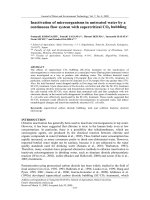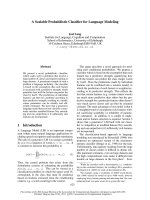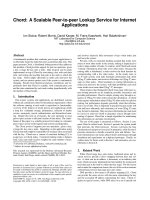SCALABLE CONTINUOUS FLOW PROCESSES FOR MANUFACTURING PLASMONIC NANOMATERIALS
Bạn đang xem bản rút gọn của tài liệu. Xem và tải ngay bản đầy đủ của tài liệu tại đây (4.53 MB, 94 trang )
SCALABLE CONTINUOUS-FLOW PROCESSES
FOR MANUFACTURING PLASMONIC
NANOMATERIALS
PRASANNA GANESAN KRISHNAMURTHY
(B.E., UNIVERSITY OF MUMBAI, INDIA)
A THESIS SUBMITTED
FOR THE DEGREE OF MASTER OF
ENGINEERING
DEPARTMENT OF CHEMICAL AND
BIOMOLECULAR ENGINEERING
NATIONAL UNIVERSITY OF SINGAPORE
2013
DECLARATION
I hereby declare that the thesis is my original
work and it has been written by me in its entirety.
I have duly acknowledged all the sources of
information which have been used in the thesis.
This thesis has also not been submitted for any
degree in any university previously.
_________________
Prasanna Ganesan Krishnamurthy
16th September 2013
ii
Acknowledgements
The two years spent as a masters student at NUS have been a fantastic learning
experience. Gladly taking me under his wing, and guiding me with a gentle push and
giving all the freedom one could ask for, my advisor Dr.Saif Khan made these
formative years in research truly a memorable experience. Looking at everyday
problems that research throws at you with scientific rigor, and that contagious
enthusiasm and excitement, Saif inspired us all. I thank him sincerely for all the
opportunities and his constant encouragement and support, and teaching me how to
appreciate research and science. I highly appreciate his endeavor for fostering such a
rich and dynamic learning environment in the research group.
I was fortunate to have had the opportunity to work with Dr. Taifur Rahman during
my first year in NUS; a fantastic mentor who was also a great colleague and friend.
The Khan Lab environment was a one filled with a fun and friendly vibe and I thank
all the people behind it. Thank you Pravien for all the help, advice, suggestions, ideas
and for all our discussions on anything and everything. Working with AJ and listening
to all his innovative (and many times crazy) new ideas for startups and fixes for
experiments, and a new perspective on everything was fun and great food for thought.
It was great knowing and working with Zahra, Abu, Dominik, Reno, Arpi, Josu, Swee
Kun, Suhanya, Sophia and all the undergraduates in the lab; thank you guys for all the
fun times in the lab and during our outings. Zahra, Reno and Arpi, it was a pleasure
knowing you guys and thanks for all the good times. Zita, your presence as a friend
and well wisher was a great support. I thank you for all the help and your friendship.
I thank Arghya, Maninder, Prhashanna, Bhargav, Rajnish,Shruthi, Neerja for their
friendship. Thank you Romil and Bharat for being great roommates and making home
a fun place to go back to at the end of the day. Many thanks to Kriti for her company
and great Indian food.
I can’t thank you enough Aditi, you have been my greatest support. Words cannot
express my gratitude towards my parents, without whose support, love and sacrifice, I
couldn’t have been here.
iii
Contents
Prologue ................................................................................................................... vi
List of Figures ........................................................................................................ viii
List of symbols ......................................................................................................... xi
Nanoparticles and Nanoshells .................................................................................... 1
1.1 Gold nanoparticles and nanoshells .................................................................... 1
1.2 Gold Nanoshell applications ............................................................................. 5
1.2.1 Imaging ..................................................................................................... 6
1.2.2 Therapy ..................................................................................................... 7
1.2.3 Drug delivery ............................................................................................. 8
1.2.4 Bioassays ................................................................................................... 8
1.2.5 Harnessing Solar energy ............................................................................ 9
1.3 Nanoshell synthesis and challenges ................................................................ 10
1.4 Overview........................................................................................................ 15
Microfluidics and Nanomaterials ............................................................................. 16
2.1 Rise of Microfluidics ...................................................................................... 16
2.1.1 High Surface to Volume ratios ................................................................. 17
2.1.2 Mass Transport ........................................................................................ 17
2.1.3 Low consumption volumes ...................................................................... 18
2.1.4 The numbers game ................................................................................... 18
2.2 Microfluidics for nanomaterials synthesis ....................................................... 21
2.2.1 Single phase microfluidic methods ........................................................... 21
2.3 Microfluidics and Gold nanoshells ................................................................. 28
2.3.1 Liquid phase reagents............................................................................... 28
2.3.2 Gaseous Reagents .................................................................................... 30
2.4 The path ahead ............................................................................................... 31
Microfluidics for nanomaterials synthesis using reactive gases ................................ 32
3.1 Introduction .................................................................................................... 32
3.2 Experimental Details ...................................................................................... 34
3.3 Synthesis of gold nanoparticles....................................................................... 38
3.4 Gold nanoshell synthesis ................................................................................ 40
3.5 Dynamical tunability of particle morphologies ............................................... 42
3.6 Gas-Liquid mass transfer ................................................................................ 45
iv
3.7 Overview........................................................................................................ 49
Scaling-up nanomaterials synthesis .......................................................................... 51
4.1 Introduction .................................................................................................... 51
4.2 Scale-up in Microfluidics ............................................................................... 53
4.3 “Milli-fluidics” ............................................................................................... 55
4.4 Concept and development............................................................................... 57
4.5 Experimental Details ...................................................................................... 59
4.6 Results and Analysis ...................................................................................... 61
4.6.1 Effect of droplet morphology and flow velocity on product quality .......... 63
4.7 Conclusion ..................................................................................................... 68
Epilogue .................................................................................................................. 70
Thesis Contributions ............................................................................................ 70
Future directions .................................................................................................. 71
Bibliography ............................................................................................................ 72
v
Prologue
Nanotechnology and nanomaterials attract a tremendous amount of interest from
academia and industry with over US$ 67.5 billion spent by the world governments for
nanotechnology based research over the past decade. As of 2011, this figure stands at
about US$ 10 billion per year worldwide and is increasing. The past decade saw the
development of numerous applications of nanomaterials ranging from sensing and
biological assays to cancer treatment, bio-imaging, drug delivery and solar energy
harvesting. Most applications especially like optical and biomedical require tight
control over nanoparticle sizes and shapes.
As nanomaterials based research reaches
maturity, the translation of such discoveries to real world technologies is limited by
the ability to synthesize speciality nanomaterials with careful control over
morphologies in large quantities. Microfluidics has emerged as a promising tool for
controlled synthesis of nanomaterials, but has mostly been limited by the complexity
of operation, costs and extremely small throughputs. This thesis aims to develop a
microfluidic method for the facile synthesis of nanomaterials with dynamic control of
morphologies, and the further scale-up such a system for achieving higher production
rates, maintaining the tunability and control possible in microreactors.
This work focuses on the synthesis of a special class of nanomaterials: plasmonic
gold-silica nanoshells. Moving away from traditionally used liquid phase reducing
agents, a gaseous reagent: carbon monoxide is used in this work. A novel droplet
microfluidic method using a parallel channel configuration is first developed for the
easy and safe integration of a toxic gas like CO in the reactor. Exploiting the
exquisitely controlled gas-liquid contacting made possible using this method and the
enhanced transport and mixing in microscale droplets, broad tunability of
morphologies (gold coverage over silica) and hence optical properties is
vi
demonstrated. Finally, building upon the parallel channel concept for introducing
gases into the system, a scaled-up millifluidic method is developed. Optimizing the
process parameters, upto 25 times increase in production rates compared to the chip
based method is demonstrated with excellent control over nanoparticle morphology.
This work aims to pave the path ahead for scale-up of microfluidic methods for the
synthesis of nanomaterials with complex and fast chemistries.
vii
List of Figures
Figure 1.1: (a) Theoretically calculated optical resonances of metal nanoshells over a
range of shell thicknesses. (b) Plasmon response of a nanoshell due to the interaction
between a sphere and a cavity plasmon. (c) Tunable optical properties of gold
nanorods by changing the aspect ratios - Top: TEM images of nanorods with
increasing aspect ratios from left to right; Bottom left: Colours exhibited by aqueous
nanorods suspensions; Bottom Right: Corresponding UV-Vis spectra of the nanorods
suspensions.
Figure 1.2: (a) Theoretically calculated optical resonances of metal nanoshells over a
range of shell thicknesses. (b) Plasmon response of a nanoshell due to the interaction
between a sphere and a cavity plasmon. (c) Tunable optical properties of gold
nanorods by changing the aspect ratios - Top: TEM images of nanorods with
increasing aspect ratios from left to right; Bottom left: Colours exhibited by aqueous
nanorods suspensions; Bottom Right: Corresponding UV-Vis spectra of the nanorods
suspensions.
Figure 1.3: (a) Schematic of nanoparticle-enabled solar steam generation (b) The
tuning of the absorption cross section of the gold nanoshells to overlap the solar
spectral irradiance. (c) Plasmonic light-trapping geometries for thin-film solar cells –
a: Trapping of light scattered by plasmonic particles at the surface of solar cell; b:
Light trapping by the excitation of localized surface plasmons in metal nanoparticles
embedded in the semiconductor; c: Light trapping by the excitation of surface
plasmon at the metal/semiconductor interface.
Figure 1.4: (a) Schematic of the steps involved in nanoshell synthesis (b) Top:
Schematic of reduction of gold ions over the surface of silica in the presence of gold
seeds; Bottom: Different stages of growth of the gold shell over the silica core.
Figure 2.1: (a) Schematic of the single phase multistage microreactor system for gold
and silver nanoparticle synthesis and TEM image of the gold nanoparticles
synthesized in this system using sodium borohydride. (b) Schematic of the
microreactor system for multistep synthesis of iron oxide-silica nanoshell structures
and TEM images showing the nanoshells obtained. (c) Photograph of the siliconpyrex microreactor for gold nanoparticle synthesis. The photo also shows the
deposition of gold on the channel walls after usage.
Figure 2.2: (a) Schematic of reagent injection and droplet generation in the device
used for gold nanorods synthesis and TEM images of gold nanorods of different
aspect ratios obtained. (b) Photograph of the device used for iron oxide nanoparticle
synthesis showing generation of droplets containing the two reagents and downstream
coalescence by electric actuation. TEM image shows the iron oxide nanoparticles
synthesized using this method.
viii
Figure 2.3: (a) Schematic of generation of foams in the microchannels for gold
nanoshell synthesis using liquid phase reducing agent. Alongside is a TEM image of
the gold nanoshells synthesized. (b) Schematic of generation and merging of droplets
and bubbles to form compound droplets for nanoshell synthesis using carbon
monoxide. On the side is a TEM image of the nanoshells obtained using this method.
Figure 3.1: Concept of membrane-based droplet microfluidic device for materials
synthesis with a reactive gas.
Figure 3.2: Schematic of the experimental setup. Insets: (i) stereomicroscopic image
of aqueous (AQ) droplet formation in fluorinated oil (FO), (ii) aqueous droplets in the
parallel channel network; carbon monoxide in the gas channel is dosed into aqueous
droplets in liquid channel through the intervening PDMS membrane. Scale bars: 300
µm.
Figure 3.3: UV-Vis absorbance spectrum of colloidal gold synthesized using the
microfluidic device. Insets: TEM image of gold nanoparticles and measured particle
size distribution.
Figure 3.4: Deposition of colloidal gold on the wall of liquid microchannel running in
parallel to CO channel.
Figure 3.5: Gold-silica core-shell particles obtained by changing only the silica
volume fraction in the reagents at a fixed residence time of 60 sec: TEM images of
230±20 nm silica particles with: (a) nano-islands (fs=4 x10-5 in 0.36 mM K-Gold), (b)
almost coalesced nanoislands (fs= 3.4 x10-5 in 0.37 mM K-Gold). (c) complete
nanoshell (fs= 2.8 x10-5 in 0.37 mM K-gold). (d) Ensemble UV-Vis spectra for all
particles (a)-(c).
Figure 3.6: (a) Ensemble optical absorbance spectra for samples from 5 batch
experiments using fs= 2.8 x10-5 in 0.37 mM K-gold (b) Ensemble optical absorbance
spectra for 6 samples collected during 6 hours of continuous microfluidic synthesis
using fs= 3.4 x10-5 in 0.37 mM K-Gold
Figure 3.7: Gold-coated silica particles obtained by changing droplet residence times
at fixed gold and silica concentrations. TEM images of 230±20 nm silica particles
(fs=2.8x10-5 in 0.37 mM K-Gold) with: (a) pre-attached gold seeds, and (b)-(d)
varying degrees of gold coverage. (e) Ensemble UV-Vis spectra for all particles (a)(d)
Figure 3.8: Gold-silica core-shell particles obtained by changing the residence times
with a fixed fs=3.1 x10-5 in 0.37 mM K-Gold : TEM images of 230±20 nm silica
particles with: (a) sparse nano-islands, (b) nanoislands, (c) almost coalesced
nanoislands (d) complete nanoshell.
Figure 3.9: (a) Plot showing fractional coverage (Fc) of gold over the silica cores of
particles (measured by digital image analysis of TEM micrographs in MATLAB TM)
ix
synthesized using two different but fixed silica particle concentrations (fs=2.8 x10-5
and fs=3.1 x10-5 in 0.37 mM K-Gold). (b) Plot of absorbance maxima in the UV-vis
spectra against residence time for particles synthesized using two different but fixed
concentrations (fs=2.8 x10-5 and fs=3.1 x10-5 in 0.37 mM K-Gold) of silica particles.
Figure 4.1: Concept of tube-in-tube based droplet milli-fluidic reactor for materials
synthesis with a reactive gas.
Figure 4.2: Schematic of the experimental setup consisting of infusion pumps, crossflow droplet generator, stainless steel (SS) outer and PTFE inner tubes. The outer tube
is pressurised with carbon monoxide. The whole setup is within a fume hood.
Figure 4.3: Gold-silica core-shell particles obtained by changing only the silica
volume fraction in the reagents at a fixed residence time of ~ 1 minute: TEM images
of 230±20 nm silica particles with: (a) nano-islands (fs=2.265 x10-5 in 0.37mM Kgold), (b) almost coalesced nanoislands (fs= 1.7x10-5 in 0.37mM K-gold). (c)
complete nanoshell (fs= 1.13 x10-5 in 0.37mM K-gold). (d) Ensemble UV-Vis spectra
for all particles (a)-(c).
Figure 4.4: Microscopic images of droplet formation using the cross flow fitting. (a)(d) show increasing droplet lengths with increasing aqueous flow rates keeping oil
flow rates constant.
Figure 4.5: Gold-coated silica particles obtained by changing droplet velocity(v) and
residence times(τ)( at fixed gold and silica concentrations. TEM images of 230±20
nm silica particles (fs= 1.13 x10-5 in 0.37mM K-gold): (a) v=5.3 mm/sec & τ =113 sec
(b) v=7.4 mm/sec & τ =81 sec (c) v=8.4 mm/sec & τ = 71 sec (d) v=9.5 mm/sec & τ
=63 sec
x
List of symbols
τ
Residence time (sec)
fs
Volume fraction of silica particles in the aqueous phase
U
Flow velocity (m/sec)
µ
Viscosity of the continuous phase (N-sec/m2)
γ
Interfacial tension between the continuous and dispersed phase (N/m)
ρ
Density of the continuous phase (Kg/m3)
D
Diffusivity (m2/sec)
H
Henry’s Law constant (mol/m3-Pa)
CS
Solubility of gas in the liquid phase (M)
Pe
Peclet number
Re
Reynolds number
Ca
Capillary number
tD
Diffusion time (sec)
tm
Mixing time (sec)
k La
Volumetric mass transfer coefficient (sec-1)
Vd
Volume of the droplet (m3)
xi
Chapter 1
Nanoparticles and Nanoshells
Silica-Gold nanoshells and nanoislands are a special class of plasmonic nanomaterials
that have garnered a lot of interest in the past decade. Beginning with an introduction
to metallic nanomaterials the advantages of such gold nanoshells are discussed. Some
of the important applications of gold nanoshells are reviewed. Finally the
conventional techniques for synthesizing these core-shell structures and the challenges
involved are discussed to better understand the need for developing alternative
microfluidic techniques for their synthesis, which is the focus of the forthcoming
chapters.
1.1 Gold nanoparticles and nanoshells
Nanomaterials today have far flung applications from medicine 1-3 to enhancing oil
recovery from reservoirs4,
5
and have tremendous attention from the research
community as well as industry6-8. Gold based metallic nanomaterials and metaldielectric hybrid nanomaterials synthesis will be the focus of this work.
Metallic nanoparticles suspensions have fascinated men for centuries with their
unique optical and surface active properties not observed in their bulk forms. From
the stained glass of roman times, to the famous Purple of Cassius 9 in the seventeenth
century to Faraday’s sols10, gold nanoparticles have attracted immense attention. The
colours exhibited by nanoparticle suspensions was attributed to the absorption and
scattering of light by the particles by Gustav Mie in 1908 11. Metals are great
conductors of heat and electricity due to the overlap of the conduction and valence
bands and the highly delocalized nature of the electrons. When the size of metals is
1
reduced to dimensions smaller than the mean free path of the electrons, intense
absorption in the near UV and visible part of the spectrum is observed. This is due to
the coherent oscillation of the free electrons on the surface of the metals at a
frequency equal of that of the electromagnetic wave.12, 13 This is known as surface
plasmon resonance (SPR). Noble metals especially gold and silver are unique,
because their free electron densities lie in a range which makes their nanoparticles
exhibit SP peaks in the visible region14. The brilliant colour of nanoparticle
suspensions is due to this phenomenon. This resonant frequency has been known to
depend on the type of metal, their dielectric environment and crucially on the size and
shape of the nanoparticles. As the size or shape of the nanoparticles change, the
change in the surface geometry causes a shift in the electric field density on the
surface resulting in a change in oscillation frequency of the electrons. 15 Manipulation
of the frequency and hence the wavelengths at which particles absorb and scatter light
has been done for years by mainly varying their sizes and shapes and their dielectric
surroundings. Metallic nanomaterials especially gold of different shapes and sizes
have found applications in diagnostics and therapy16-18, assays19-20, bio-imaging21,
drug delivery22, nanomedicine23,
24
, biosensing25, photo-catalysis26 and more.
Bottom-up methods (starting from molecular level to desired structures) are widely
used for the controlled synthesis of metallic nanomaterials. The mechanism of
formation of nanoparticles usually involves two steps: nucleation followed by
growth27. Most metallic nanoparticle syntheses (leaving aside kinetically controlled
growth mechanisms28 of anisotropic particles) are characterized by very fast
nucleation and growth kinetics. Tight control over the nucleation and growth stages is
necessary29, 30 to obtain monodisperse sizes and shapes of such nanoparticles.
2
The limitation here is that the tunability of the plasmon resonance of solid gold
nanoparticles is restricted as the resonance frequencies shift to longer wavelengths
only with increasing particle sizes and the plasmon response to size change is found to
be weak.31 Capitalizing on the fact that the plasmon resonance also depends on the
dielectric constant of the surrounding medium, the attachment of solid nanoparticles
to larger beads or supports was found to give unique optical properties. In the late
1990s, the Halas group at Rice University introduced a new type of hybrid particle
where a dielectric nanoparticle: silica was decorated with gold nanoparticles32. This
new breed of metallodielectric nanoparticles known as gold nanoshells exhibited
enhanced optical properties compared to solid nanoparticles of equivalent size.33 The
equivalent plasmon response of a nanoshell was attributed to the interaction of
plasmons, characteristic of a sphere and a cavity.34 The unique property was the facile
tunability of the optical response by changing the physical characteristics. Unlike gold
nanoparticles gold nanoshells could be used to access a wide range of wavelengths.
By changing the control parameters like size of the silica core, thickness of the shell
and coverage of gold over the silica surface, SP bands of these particles could be
shifted continuously from wavelengths ranging from the visible to the near-infrared
regions of the electromagnetic spectrum31. This kind of functionality provided a great
amount of freedom to design such particles and tailor them for specific applications.
Spherical gold or silver nanoparticles could not be used to achieve this kind of facile
optical response. Other nanoparticle geometries that displayed such shape based
tunability were obtained when anisotropy was introduced, the most popular among
which has been gold nanorods.31 The plasmon in nanorods could be tuned by varying
their aspect ratios. The aspect ratio defines the two resonance frequencies
corresponding to the interaction of light with the longitudinal and transverse
3
dimensions of the nanorods.12 Nanorods are produced by introducing shape inducing
agents like surfactants during the growth step of the synthesis.35,
36
By adhering to
specific facets of the nuclei the surfactants do not allow further deposition and growth
in those facets thereby introducing anisotropy.37,
38
Nanorods and this family of
nanomaterials have been useful for various applications especially for bio-imaging
and therapy.18,
39
Nanorods are mostly synthesized using CTAB (cetyl
trimethylammonium bromide), a surfactant which as mentioned earlier acts as a
shaping and importantly as a capping agent. Due to the cytotoxicity of CTAB,
applications of nanorods are currently limited.40 Also since they are highly surfactant
stabilized, the loss or removal of these surfactant layers or just storing for prolonged
time periods causes them to lose their shape. Nanoshells on the contrary are
structurally stable, and have been found to be benign and biocompatible and can be
further surface functionalized with a variety of substrates for different applications:
biological and otherwise. Ever since their conception by Halas and group, this family
of core-shell structured nanomaterials have received much attention and fuelled
intense fundamental and applied research.
4
Fig 1.1: (a) Theoretically calculated optical resonances of metal nanoshells over a range of shell
thicknesses.32 (b) Plasmon response of a nanoshell due to the interaction between a sphere and a cavity
plasmon.31 (c) Tunable optical properties of gold nanorods39 by changing the aspect ratios - Top: TEM
images of nanorods with increasing aspect ratios from left to right; Bottom left: Colours exhibited by
aqueous nanorods suspensions; Bottom Right: Corresponding UV-Vis spectra of the nanorods
suspensions.
1.2 Gold Nanoshell applications
The facile ability to tune the absorption frequency of gold nanoshells has been their
greatest advantage. The ability to tune the resonance of nanoshells near the infrared
part of the spectrum combined with their bio-compatibility and their ease of
bioconjucation make them ideal for a variety of biomedical applications41, 42. The two
5
major focus areas as far as application of nanoshells go have been bio-imaging and
photo thermal therapy. The near-infrared part of the spectrum called the “water
window” is the region where the physiological transmissivity of tissues and blood is
the highest and where they act transparent letting light to penetrate through them with
minimal heating and scattering limited attenuation. Light in this spectral region has
been observed to penetrate more than 1cm into the tissues without any observable
damage43.
1.2.1 Imaging
Conventionally organic fluorescent dyes and NIR dyes such as indocyanine green
have been tested and used as contrast agents for imaging cancer cells. Even though
optical imaging using such dyes is cheap, it is limited by weak optical signals and lack
of contrast between the tumorous and surrounding benign tissues. Gold nanoshells
owing to their excellent absorbance properties and biocompatibility have been used
effectively for such imaging purposes44. Compared to a dye like indocyanine, gold
nanoshells have been found to be more than a million times more absorbent towards
NIR light. Thus excellent contrast can be achieved using such nanomaterials. Also the
structural stability of nanoshells makes them less susceptible to in-situ chemical or
thermal degradation than conventional dyes. The ability to functionalize the nanoshell
surfaces easily with bio-molecules or conjugate with antibodies and biomarkers make
selective uptake possible. Thus the nanoparticles attach only to the targeted malignant
tissues and not the surroundings thereby making contrast based imaging easier (Fig
1.2a). Halas and West have demonstrated conjugation of nanoshells with anti-HER2
breast cancer biomarkers for in-vitro imaging of the cancerous tissues45.
6
1.2.2 Therapy
Non invasive thermal ablation of tumors involves the administration of a minimal but
lethal dose of heat to the target tissues. Conventionally this is done by placing probes
in the interstices or between cavities. Ultrasound, Laser, RF and microwave therapies
which are extracorporeal have also been demonstrated.
However all such therapies
suffer from the same limitation: non-specific delivery of heat resulting in death of
surrounding tissues. Tumor specific heat treatment has been done by heating iron
oxide nanoparticles using altering magnetic fields. However for effective treatment
this method needed large quantities of iron nanoparticles to be delivered to the tumor
sites.
Gold nanoshells can be easily conjugated with biomolecules so that they specifically
attach to the target cells and can be used for high contrast imaging as discussed in the
previous section. Since nanoshells are intense absorbers (a million times stronger than
conventional dyes), when NIR light of the resonant wavelength of the nanoshells is
administered, the amount of heat generated locally due to the conversion of the
electron kinetic energy to thermal energy is capable of destroying the surrounding
tissues. Due to the leaky nature of cancer tissues, nanoparticles smaller than 400nm
have enhanced permeability and retention within such cells, making therapy more
effective and localised45. Halas and West have demonstrated extracorporeal photo
thermal ablation of tumors in-vitro as well as in-vivo (in mice). Using PEG
functionalised NIR absorbing gold nanoshells and NIR lasers, they were able to
induce localised cell death confined to the nanoshell treatment area (Fig 1.2a).
Interestingly incubation of these cells with PEG coated nanoshells without any NIR
treatment resulted in no cell mortality thereby proving the non-cytotoxic nature of
gold nanoshells43.
7
1.2.3 Drug delivery
The same principle of heat generation by absorption at resonant wavelengths has been
exploited for controlled release of drugs. Drug-laden temperature sensitive hydrogel
embedded with nanoshells, when exposed to light, experience temperature increase
due to the heat generated at the surface of the nanoshells thereby causing the
hydrogels to rupture and release the contents. Acrylamide based reversible polymeric
hydrogels embedded with gold-gold sulphide nanoshells that absorb at the NIR part of
the spectrum have been demonstrated for controlled drug delivery46. When exposed to
NIR laser the hydrogels collapse thereby releasing the contents. Due to the sudden
collapse the drugs experience convective release into the environment. When the NIR
source is stopped, the gels swell back in sometime thereby stopping drug release.
Fig 1.2: (a) Combined imaging and therapy of SKBr3 breast cancer cells using HER2-targeted
nanoshells.45 The top row shows the increase in contrast during imaging while using target specific
functionalized nanoshells. The middle row shows the highly localized cell death using anti-HER2
functionalized nanoshells. Bottom row shows the silver staining assessment to determine nanoshell
binding (dark spots) (b) Gold nanoshells for blood immunoassays UV-vis spectrum of disperse
nanoshells and spectrum of nanoshells/antibody conjugates following addition of analyte.47
1.2.4 Bioassays
Nanoshells due to their strong optical signals have been used for immunoassays to
determine target analyte concentrations in blood. In conventional optical
immunoassays carried out under visible light, several purification steps are involved
since a variety of biomaterials present in the sample absorb visible light. Nanoshells
8
that absorb in the near IR part of the spectrum can be conjugated with antibodies that
interact with the specific analyte of interest. In the presence of the analyte the
nanoshells in the blood aggregate to form dimers. The formation of dimers causes a
red shift in the plasmon response of the suspension (Fig 1.2b).47 When conducted
using near-IR light, the optical signals by other biomolecules present in the blood is
minimal and careful quantification of the target analyte can be carried out.
1.2.5 Harnessing Solar energy
Due to the greatly tunable nature of the optical properties of nanoshells they have
been recently even used to more efficiently harness solar energy. By tailoring the
Fig 1.3: (a) Schematic of nanoparticle-enabled solar steam generation 49 (b) The tuning of the
absorption cross section of the gold nanoshells to overlap the solar spectral irradiance. 49 (c) Plasmonic
light-trapping geometries for thin-film solar cells – a: Trapping of light scattered by plasmonic
particles at the surface of solar cell; b: Light trapping by the excitation of localized surface plasmons in
metal nanoparticles embedded in the semiconductor; c: Light trapping by the excitation of surface
plasmon at the metal/semiconductor interface.50
shape and size of gold nanoshells and creating a mixture of these particles such that
they absorb strongly across the solar spectrum, maximum utilization of sunlight can
9
be done (Fig 1.3b).48 Halas and group have used this technology for developing solar
steam generators. The intense heat generated at the surface of the nanoparticles when
light is incident upon them is used to evaporate the surrounding water (Fig 1.3a). 49
Such tailored nanoshells have also been tested to be used in photovoltaic cells in order
to increase absorption efficiencies and also induce light trapping (Fig 1.3c). 50
1.3 Nanoshell synthesis and challenges
The synthesis of silica-gold core shell nanostructures is carried out by growing
nanometre scale gold film onto colloidal silica pre-seeded with small gold
nanoparticles. The silica nanoparticles are synthesized separately, using the now
standard one step Stober / modified Stober process51 or the seeded growth process for
synthesizing silica particles of larger sizes with high monodispersity52. In order to
decorate the silica surface with gold nanocrystals, its surface is first modified with
functional molecules to enhance coverage of gold. The surface is modified commonly
by using various silanes53, 54. The most commonly used APS (3-aminopropyltriethoxy
silane) is a bi-functional organic molecule having an ethoxy group on one end and NH
group on the other. The ethoxy group forms a bond with the OH terminated silica
surface thereby making the surface now NH terminated. Gold nanoparticles in the
range of 2-4 nanometres are synthesized by reducing chloroauric acid by
tetrakishydroxymethylphosphonium chloride (THPC) which also acts as a capping
agent55. These THPC gold particles are negatively charged56. When introduced into a
solution containing the APS coated silica particles, these gold nanoparticles attach to
the surfaces due to electrostatic attraction.
In order to grow a shell onto the seeded
surface, a gold plating solution is used. The plating solution is an aged mixture of
chloroauric acid and potassium carbonate. Addition of potassium carbonate increases
10
the pH to about 7.5 and results in the hydrolysis of gold chloride to form various gold
chloride – hydroxide species, the most dominant being AuCl3(OH)- , AuCl2(OH)2AuCl(OH)3-. This speciation of chloroauric acid has been shown to favour the size
controlled gold nanoparticle synthesis. However at higher pH (pH> 10), Au(OH)4species is seen to dominate which has been found to have lower tendency to be
reduced therebye affecting nanoparticle synthesis and growth. To initiate the growth,
the seeded silica particles are added to the plating solution in the presence of a
reducing agent.
Fig 4: (a) Schematic of the steps involved in nanoshell synthesis54 (b) Top: Schematic of reduction of
gold ions over the surface of silica in the presence of gold seeds; Bottom: Different stages of growth of
the gold shell over the silica core.32
Here the Au3+ ions from the plating solution are reduced to Au0 onto the silica surface,
catalysed by the pre-seeded gold nanoparticles on the lines of electroless plating. This
causes the existing gold nanoclusters on the surface to grow and coalesce to form
nano-islands and eventually form a continuous gold shell.
The nanoshell growth method was first demonstrated by the Halas group using
sodium borohydride as the reducing agent 53. However NaBH4 being a very strong
reducing agent, it gave rise to secondary nucleation thereby causing non-homogenous
growth as well as colloidal gold formation in the surrounding liquid phase. Graf and
11
van Blaaderen later adopted the use of hydroxylamine hydrochloride as the reducing
agent which resulted in good nanoshells54. Halas later demonstrated the use of
formaldehyde with ammonium hydroxide for synthesizing silver nanoshells that was
adopted even gold nanoshell synthesis57. This method in particular gave smooth
nanoshell morphologies.
Recently Halas and group extended the use of carbon
monoxide, a gas that has been previously used for a variety metal nanomaterials
synthesis58-61, for the synthesis of gold nanoshells.62
Here instead of formaldehyde or hydroxylamine hydrochloride, CO acts as a reducing
agent providing the necessary electrons to reduce Au+3 to Au0. CO dissolves in the
aqueous solution containing the reagents and reacts with water thereby providing the
necessary free electrons.
CO( g ) H 2O CO2(aq ) 2e 2 H
CO( g ) 2 H 2O HCO3 2e 3H
The reduction of Au+3 from the salt to Au is a two step process. The Au+3 is initially
reduced to AuCl2− and then to Au0.
AuCl4 2e AuCl2 2Cl
AuCl2 e Au 0 2Cl
During the gold shell growth, CO adsorbs on the surface of the existing gold
nanoparticles and reacts with water to give carboxyhydroxyl intermediates which then
dissociate to give carbon dioxide and free electrons. These free electrons are then
taken up gold chloride- hydroxide species physisorbed on the nanoparticles and are
reduced to Au0. The existing seed gold nanoparticles, as mentioned earlier, behave
like a catalyst by acting as a conduit for electron flow from CO to the gold salt as the
gold deposition and growth process progresses60.
12
The morphology of nanoshells has been reported to be influenced by the reducing
agent used and using CO was found to produce thinner shells62 than all other liquid
phase reagents; a quality that is highly desirable from the point of view of plasmon
tunability (thinner shells lead to resonance at longer wavelengths). Even though liquid
phase reagents have been used widely for materials synthesis gaseous phase reagents
are gaining popularity due to their inherent advantages; they do not degrade with time
as is common with their liquid analogues, produce simple by-products, and are easy to
separate from the liquid-phase reaction mixture. Nanomaterials synthesis invloves
careful control over reagent concentrations, but many liquid phase reagents lose
activity or degrade over time thereby rendering them useless and causing variations in
the experimental conditions; for example sodium borohydride (NaBH4) has to be kept
cooled before usage to avoid hydrogen gas evolution causing reduction in activity.
However gaseous reagents are highly stable and can be stored for extended periods
without any loss of activity. The other major advantage is the ease with which the
gaseous reagents can be separated. In wet chemical methods the addition of excess
reducing agent is not uncommon to ensure complete reaction. The separation of the
excess reagents then becomes a post processing challenge. Reagents like
formaldehyde and hydroxylamine hydrochloride that are used commonly for gold
nanoshell synthesis, are highly toxic, making their careful removal imperative when
the end product is needed for biomedical applications. While using gaseous reducing
agents like CO, by-products like CO2 and the excess gas escape into the ambient
atmosphere making a separation step unnecessary. Carbon monoxide has also been
known to adsorb easily onto gold surfaces, which has raised concerns about the safety
of the gold nanoparticles synthesized thereof. However supported gold nanoparticles
have been established as an effective catalyst for oxidation of carbon monoxide even
13
at low temperatures63, thus making the likelihood of residual carbon monoxide bound
to gold nanoshell surfaces highly remote.
The ease of separation of gaseous reagents also makes rapid reaction quench possible
which is difficult while using liquid phase reagents.
Due to the high dependence of optical properties on the size, shape and morphology
of such nanoparticles tight control over these characteristics becomes essential.
Synthesis of such gold nanoshells using electroless plating is usually characterized by
rapid autocatalytic reaction kinetics. Duraiswamy and Khan, in a diffusion controlled
environment estimate shell growth rates upto 200nm/sec with the growth going to
completion within seconds64. Growing uniformly thick shells on all particles to get
monodisperse populations thus requires rapid reagent dispensing and homogenization.
Carrying out such syntheses involving fast kinetics in batch scale methods using
stirred vials or reactors, makes the process highly mass transfer controlled. The
mixing induced by traditional stirrers proves to be insufficient and slow resulting in
pockets of inhomogeneities within the reaction mixture. This causes different extents
of shell growth on particles at different places within the reactor resulting in
polydisperse product populations65. Improper mixing also leads to nucleation and
growth of gold nanoparticles outside the silica surface in the surrounding liquid phase.
Valuable gold precursors get wasted as a result and the product requires an additional
post-processing / cleanup step. It is therefore not surprising that even in single-phase
solution based methods, nanoshells with control over morphology are synthesized
only in small volumes using conventional flask-based batch processes, with limited
reproducibility and often insurmountable issues with scale-up. The use of a gaseous
reducing agent in conventional batch synthesis, while conferring several advantages
as noted above, exacerbates the problem of reagent addition and homogenization, as
14









